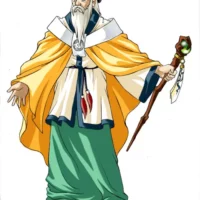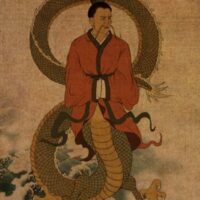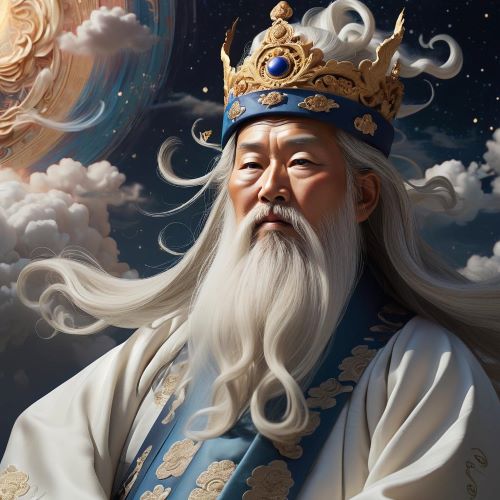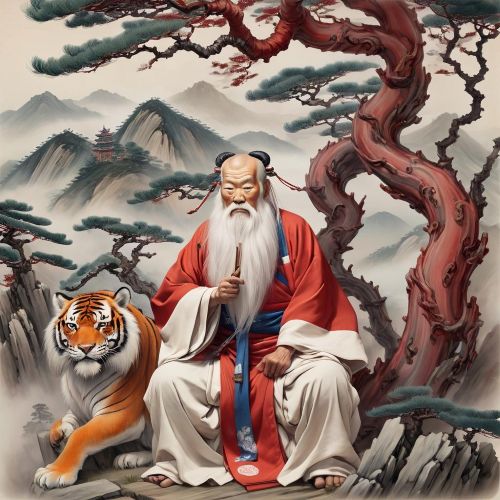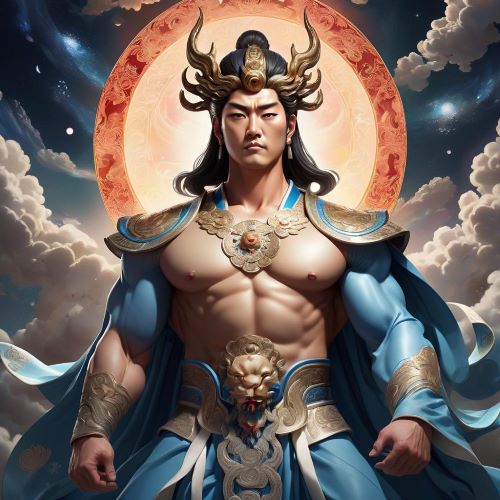Habaek : God of the River
Listen
At a glance
| Description | |
|---|---|
| Origin | Korean Mythology |
| Classification | Gods |
| Family Members | Yuhwa, Wuihwa, and Hweonhwa (Daughters) |
| Region | Korea |
| Associated With | Rivers, Water |
Habeak
Introduction
Habaek, the river god of Korean mythology, holds a revered position as the divine guardian of the Amnok (Yalu) River. Unlike many mythological figures, Habaek’s significance lies not only in his supernatural power but also in his direct role in shaping royal lineage. His story is deeply embedded in the foundational myths of the Goguryeo kingdom, where gods interacted with mortals, giving rise to legendary heroes. Though often compared to Hebo, the Chinese god of the Yellow River, Habaek is an entirely distinct figure with roots unique to the Korean peninsula.
Physical Traits
Habaek is not frequently described in precise physical terms, but his essence as a river deity gives him an aura of grandeur and fluidity. Symbolically, he is often imagined as a majestic being radiating the strength and unpredictability of the river itself. Mythical narratives highlight his ability to take the form of various animals, underscoring his identity as a shape-shifter. This ability doesn’t merely signify magical prowess—it reflects his intimate connection with nature’s cycles and the untamable force of water. These features place him among the more dynamic figures in Korean mythology.
Family
In Korean mythological tradition, Habaek is most remembered through his familial ties, particularly as the father of Yuhwa. Yuhwa’s tale is one of divine love, conflict, and exile. Her encounter with Haemosu, the heavenly son of the sun god, forms a central myth in Korean folklore. Although Haemosu sought her hand, Habaek opposed the unsanctioned union, demanding a formal commitment. What followed was a mythic contest in which Habaek tested Haemosu through transformations into various creatures—only to be defeated each time. After reluctantly allowing the union, Habaek’s relationship with his daughter became strained, leading to her banishment. Through Yuhwa’s later son, Jumong, Habaek’s bloodline contributed directly to the royal lineage of Goguryeo.
Other names
Habaek is known by several appellations, reflecting both linguistic variations and interpretive differences over time. Names like Habak and Haebalk appear in different records, hinting at either transliteration discrepancies or overlapping identities. Some scholars speculate that “Haebalk” suggests a solar association, though this view isn’t universally accepted. The use of Hanja (Chinese characters) like 河伯 and 河泊, which mean “river lord,” further affirms his role in East Asian river mythology. However, these titles are distinct from Hebo, despite phonetic similarities, emphasizing that Habaek belongs specifically to the Korean mythos.
Powers and Abilities
As a river deity, Habaek wields control over the elemental domain of water. His power is most vividly portrayed in the transformation duel with Haemosu. Switching between a carp, deer, and quail, Habaek challenged his rival across multiple ecosystems—water, land, and sky. This battle wasn’t just a show of magic but symbolized dominion over nature’s many facets. His abilities likely extended beyond transformation to control over river currents, seasonal floods, and possibly the fertility of surrounding lands. Through these traits, he was not just a guardian spirit of a river but a cosmic force influencing life and balance in the region.
Modern Day Influence
Despite being an ancient figure, Habaek remains alive in Korea’s cultural imagination. One of the most notable modern retellings is the 2017 drama The Bride of Habaek, which places him in a fantasy-romance narrative that bridges ancient mythology with the modern world. The series reimagines him as a young water god navigating urban life, reinterpreting age-old themes of power, love, and destiny. Beyond media, Habaek is also a subject of academic exploration, especially in studies focused on Korea’s mythological influence on early statecraft. Through television, literature, and scholarly discourse, Habaek continues to shape Korea’s understanding of its mythical and historical roots.
Related Images
Source
Contributors to Wikimedia projects. (2017). Habaek – Wikipedia. https://en.wikipedia.org/wiki/Habaek
Habaek | Facts, Information, and Mythology – Encyclopedia Mythica. (2000). https://pantheon.org/articles/h/habaek.html
Publication | The Academy of Korean Studies. (2005). Culture Focus – Toward Globalization of Korean Studies. https://www.aks.ac.kr/cefia/webzine/2204/focus_eng.html
Contributors to Wikimedia projects. (n.d.). The Bride of Habaek – Wikipedia. https://en.wikipedia.org/wiki/The_Bride_of_Habaek
Contributors to Wikimedia projects. (2007). Lady Yuhwa – Wikipedia. https://en.wikipedia.org/wiki/Lady_Yuhwa
goddessRhoda. (n.d.). Korean Mythology – Haemosu – Wattpad. https://www.wattpad.com/723270540-korean-mythology-haemosu
Frequently Asked Questions
What is lorem Ipsum?
I am text block. Click edit button to change this text. Lorem ipsum dolor sit amet, consectetur adipiscing elit. Ut elit tellus, luctus nec ullamcorper mattis, pulvinar dapibus leo.
What is lorem Ipsum?
I am text block. Click edit button to change this text. Lorem ipsum dolor sit amet, consectetur adipiscing elit. Ut elit tellus, luctus nec ullamcorper mattis, pulvinar dapibus leo.
What is lorem Ipsum?
I am text block. Click edit button to change this text. Lorem ipsum dolor sit amet, consectetur adipiscing elit. Ut elit tellus, luctus nec ullamcorper mattis, pulvinar dapibus leo.
What is lorem Ipsum?
I am text block. Click edit button to change this text. Lorem ipsum dolor sit amet, consectetur adipiscing elit. Ut elit tellus, luctus nec ullamcorper mattis, pulvinar dapibus leo.
What is lorem Ipsum?
I am text block. Click edit button to change this text. Lorem ipsum dolor sit amet, consectetur adipiscing elit. Ut elit tellus, luctus nec ullamcorper mattis, pulvinar dapibus leo.



